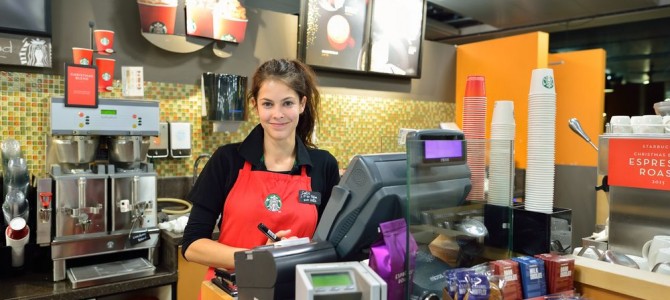
Starbucks announced recently it will open its first Italian store in Milan in 2017. I reacted to this news the only way anyone should: with absolute horror. I appreciate Starbucks for what it offers — namely, decent coffee with a decent atmosphere at a decent price — but I’m not naïve enough to believe it’s wise for the company to move into Italy. America does a lot of things well. Coffee is not usually one of those things.
I studied in Rome for nine months between 2013 and 2014. My campus was American, but I wasn’t sheltered from Italian culture, and coffee is up there with pasta and wine as integral to Italian identity.
It is difficult to describe exactly the significance coffee has in Italy, especially if you’ve never experienced it for yourself, but (from my American perspective) there are at least three aspects to it: utility, taste, and experience. American coffee, and Starbucks in particular, is able to replicate to a certain extent all three of those aspects, but Italians have perfected them.
Italy’s Coffee Experience
My campus was located on one of the many hills of Rome. It was a bit removed from the historic city center but had as many local cafes as an American neighborhood would have Starbuckses. My classmates and I frequented one café in particular. It technically had a name — L’appuntamento, “the appointment” — but we never called it that. Since it was on a corner, we just called it Corner Bar.
There was nothing inherently special about Corner Bar. It was relatively small, used gaudy blue plastic tables and chairs for outdoor seating, and really just existed to provide coffee to the masses. But Corner Bar also provided an excellent atmosphere for the American students who frequented it (and probably buoyed it financially). The owner was welcoming despite not speaking English, the locals didn’t sneer at us, and the coffee was exquisite. It was an Italian café for Italians, with some Americans on the side. We were the outsiders, but we liked it that way.

A typical Italian coffee experience in Italy goes something like this: a cappuccino for breakfast, maybe with a cornetto as a side, an after-lunch shot of espresso, and perhaps another espresso after dinner. The whole process takes about ten minutes. That’s it. There is no such thing as a venti nonfat Frappuccino with extra whipped cream and Sugar in the Raw, and no one nurses a coffee for two hours while browsing the web or doing freelance graphic design on a laptop.
Indeed, if you go into an Italian cafe and order a latte without the cafe you get a cup of steamed milk. I know, because I made the mistake of doing it. Further, there is no foam art in Italian cappuccinos, drip coffee doesn’t quite exist, and there are typically just two drink sizes: cappuccino and espresso. Hence the utility of Italian coffee. It serves a purpose — either a breakfast in itself, or an afternoon pick up — in a way that American coffee just doesn’t, no matter how hard we try to assign it one. If American coffee had purpose like Italian coffee does, we never would have invented Folgers.
Location Convenience Versus Product Quality
Of course, the utility of Italian coffee comes with a taste that is totally absent in American coffee. When I returned from Rome after nine months of Italian coffee, my first American coffee tasted like ash in a cup. By now I have readjusted, and I’ve learned which coffees I like. American coffee tastes good now, but the fact is Italian coffee always has and always will taste better. There is a fullness and a balance to it that is difficult to replicate in the States.
Some cafés do it better than others, but on the whole American coffee is lacking. It is like eating just the heels of a loaf of bread: they’re still bread, and people eat them, but everyone knows the other slices are better. American coffee is the heels; Italian coffee is the rest of the loaf. An Italian cappuccino, for instance, blends the milk, coffee, and water together extremely evenly, so when the components mix complement each other. In my experience with American cappuccinos (from Starbucks and elsewhere) they tend to break down into a milky mess that becomes unappealing.
The utility and taste of Italian coffee come together to form a coffee experience that not even Starbucks can replicate. Starbucks, for its part, makes a significant amount of its revenue not from the coffee, which can be hit and miss, but from the atmosphere it provides to the customer. Wired describes this atmosphere well: “it doesn’t simply offer its customers buckets of coffee, but also a kind of neutral, inoffensive space that’s familiar enough to be comforting, yet blank and generic enough to lend itself to whatever meaning people want to project on it.”
This is completely true. How many people go out of their way for the quality of a Starbucks cappuccino? Probably not many. How many go out of their way because Starbucks is a good place for meetings, dates, and work? A lot.
Observers of the coffee market, Wired among them, believe Starbucks will succeed in Italy because it sells an atmosphere. Perhaps that will actually work in Milan, which is more like the rest of Europe than it is like the rest of Italy, but if Starbucks ever moves to Florence, Rome, or Naples it will fail spectacularly. Italians are not into coffee to guzzle it or because their favorite cafe offers an atmosphere others don’t or because they can’t afford to fall asleep at work. Italians like their coffee for the coffee.
Or, to put it another way, Americans use coffee; Italians experience it.









